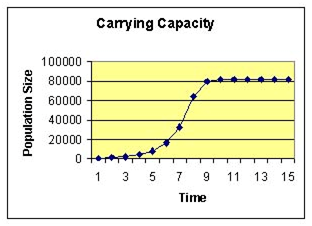Explain the carrying capacity in ecology?
Carrying Capacity : We have seen that natural populations do not normally achieve the maximum intrinsic rate of natural increase, or the reproductive potential of which they are theoretically capable. Diseases and predators usually serve to reduce the population in addition to natural death, and it is rare situation in which all of the critical factors and resources would not be limiting. Populations in general will continue to increase until they approach what is referred to as the carrying capacity of the space they inhabit.
Carrying capacity then, refers to the ultimate stable number of individuals, a given set of environmental factors is able to support over time. In other words, carrying capacity is equivalent to the limit, which is determined by the critical environmental factor or limiting resource. The growth rate of a population (its rate of increase) is equal to the potential increase of the population multiplied times the part of the habitat that is still not exploited or used. This can be expressed in the following way:
dN/dt = rN(K-N/K)
Where the rate of growth of the population (dN/dt) equals the populations rate of increase (r) multiplied times the number of individuals (N) multiplied times the carrying capacity K minus the number of individuals N divided by K.

What does this mean? Basically, it means that as the population increases, the fraction (K-N/K) gets smaller. If N is small, the value is close to 1. However, when N increases, the value becomes a smaller fraction of 1. Since rN is now multiplied times a smaller factor, the r, or growth rate declines. Carrying capacity can thus be graphed as seen below.
As you can see, the shape of the curve is distinctive in that it is S shaped, showing that the growth levels off and varies slightly around a stable carrying capacity determined by the environment.